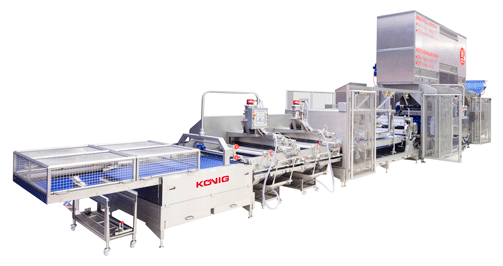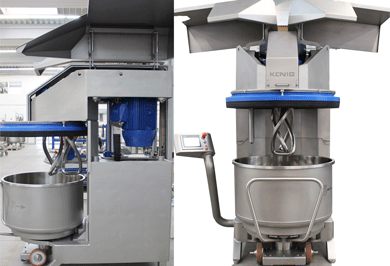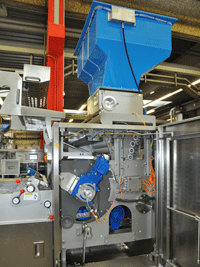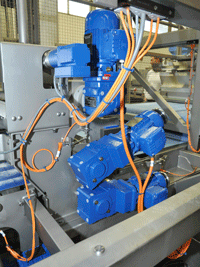Baking rolls on a large scale
With an output of up to 45,000 rolls per hour, the KGV-H industrial bread roll line from the Austrian manufacturer Koenig sets new performance standards. It is fully designed according to hygiene stand-ards, which impose special requirements on the drive technology. Low-voltage motors from WEG and geared motors from WEG’s subsidiary Watt Drive keep the dough moving. At the end of the process chain, the tasty baked goods – fresh rolls, baguettes, ciabatta, hamburger buns or other fine baked goods – drop onto the baking sheet.

Koenig has been making machines for commercial and industrial bakeries for 50 years, with the main focus on the core competence of dough processing: dividing, forming and baking. The current product portfolio encompasses the entire production chain of bakery technology. In 2015, the world market leader in machines and systems for producing small baked goods was honoured with the international IBA Award for its new hygienic KGV-H bread roll line.
Hygiene: easy cleaning is key
The hygienic design of the bread roll line imposes especially stringent requirements on its components. For instance, the motors and geared motors must comply with the IP66 specification, which means they must be dust-tight with 20 mbar negative pressure inside the housing and protected against water jets. This ensures that they are reliable and failsafe with low maintenance effort in the entire production process, including hygienic cleaning of the entire line.
All geared motors used in the machine are additionally equipped with thermal protection (TH/TF) and class F2 humidity protection. To avoid corrosion despite the high humidity level, the terminal box and fan covers of all motors are secured by screws with especially high corrosion resistance. The gamma ring seals on the fan end of the geared motors are also made from this special material.
 |
| Picture 1: The KGV-H bread roll line, hygienic version (Source: Koenig) |
Special paint
The paint for the motors (painting plan 212E) corresponds to paint structure LC5 of the geared motors, making it compliant with corrosion class C5-I/C5-M of EN ISO 12944-5 (NDFT 320 µm). This elaborate painting scheme, based on multiple prime coats, is actually intended for shipbuilding and offshore applications and therefore able to withstand extreme environmental conditions. The bearing shield and the shaft at NDE, as well as the inside of the fan cover, are finished with this special paint.
In food manufacturing, it is essential to avoid harmful foreign substances in the product. For this reason, the hygienic motors and gear units are painted in RAL 5010, a blue tint that is not present in any dough. This allows even small foreign objects in the food to be detected immediately. In addition, only food-compatible oils are used in the gear units.
It starts with the dough
Every manufacturing process for small baked goods starts with mixing and kneading the dough. In the DW 240-H hygienic dual-shaft mixing machine, the dough is mixed by a WEG W22 induction motor with IEC 200L frame size and reinforced bearings, supplementary tropical insulation and special corrosion-resistant sealing.
Built to IP66 specification, the W22 motor can be switched to four or eight poles with a rated power of 27 or 17 kW, respectively. It drives two mixing tools with special twists, arranged at the optimal working angle relative to each other to enhance kinetic energy transfer to the dough. That shortens the mixing time and incorporates more air and oxygen in the dough.
Another pole-switching geared motor turns the dough bowl, which can hold up to 240 kg of dough. With a rated power of 1.5
or 2.5 kW, this motor produces a torque of 840 or 651 Nm, respectively.
 |
| Picture 2: The W22 motor of the dual-shaft mixing machine. A geared motor from Watt Drive turns the mixing bowl (Source: Koenig) |
Dividing and rounding
After mixing, the dough is placed in a pre-portioning hopper for further processing. This is where the Industrie Rex AW-H dividing and rounding machine comes into play – an essential component of the modular KGV-H bread roll system. Precisely divided dough portions are formed by starwheel rollers and conveyed to the weighing area by a dough pusher driven by a 250 W geared motor equipped with an adjustable safety clutch running in an oil bath.
Then the dough portions are fed out to a transfer belt. Here the motive power is provided by a smaller, unventilated 60 W geared motor with a rated torque of 254 Nm and an enclosed 5 Nm brake with IP66 protection in the weighing drum.
The dough portions are then rounded by an oscillating tumbler drum. The main drive of the dough dividing and rounding machine is a 4 kW geared motor with a rated torque of 747 Nm. Here the external fan and enclosed brake with 60 Nm braking force are also IP66 compliant. After rounding, the dough balls are fed out on the spreading finger belt and seeded with flour, on their way to the pre-prover, with the aid of a 120 W geared motor. The transfer belt to the stamping station directly below the pre-prover is driven by a 370 W geared motor and a smaller 180 W geared motor.
Forming the rolls
All stamping, pressing and cutting processes take place in the first pre-prover of the bread roll line. This also includes stamping the cooled dough balls to give them the right shape, such as Kaiser rolls or other types of baked goods. The duster that prepares the dough balls for the stamping station is driven by a 120 W geared motor, while a stronger geared motor with a rated power of 1.1 kW, a torque of 158 Nm and a shaft speed of 57 rpm powers the stamping station mechanism. After this the dough balls pass through the forming station, where the processes are powered by another pair of geared motors with rated power of 120 W and 370 W, respectively.
The RR 1000 or RR 1300 dual rollout head is driven by two geared motors rated at 250 W and 120 W, re-spectively. The dough can be dampened and seeded after the final prover before transfer to the baking sheet at the end of the production sequence. Here as well, geared motors from Watt Drive ensure high throughput – as much as 50 per cent more than the usual commercial bread roll lines.
 |
 |
|
| Picture 3: Interior view of the Industrie Rex AW-H dividing and rounding machine, showing the geared motor and main drive. |
Picture 4: Geared motors from Watt Drive |
From dough to bread rolls
Through the entire production process, drives from WEG power the modular KGV-H small baked goods line, which can consist of four to twenty-five machines depending on the specific configuration. In collaboration with Koenig, the internationally active solution provider for drive technology developed a tailored solution to implement the special hygienic design. Along with high performance, low maintenance and fail-safe operation, the drives conform to UL, CSA, CE and EAC standards. The special wide range winding and nine-bolt terminal board are another major advantage. Thanks to easy wiring configuration (DD or YY) for various world voltages, these geared motors can be deployed worldwide. That is important for Koenig because their machines and systems for producing small baked goods are distributed globally. For example, the first KGV-H system was commissioned at the premises of a customer in the USA.
The geared motors are also ideally suited for operation with electronic speed control. Their 87/100/120 Hz voltage/frequency characteristic enables variable speed drive with no need for a special winding. To meet Koenig’s requirements for flexible mounting, the geared motors are supplied suitable for every installation situation.
Dietmar Kukovec, Purchasing Manager at Koenig, comments: “We have maintained close contact with Watt Drive for many years. Our machines are modular and built to meet specific customers’ wishes, so we need tailored drives for each application. These requirements are especially stringent for our new hygienic lines. Flawless operation of all parts is essential to make the sum of the parts a perfect machine. For our lines we trust in the high reliability and availability of the motors and gear units from WEG.”
